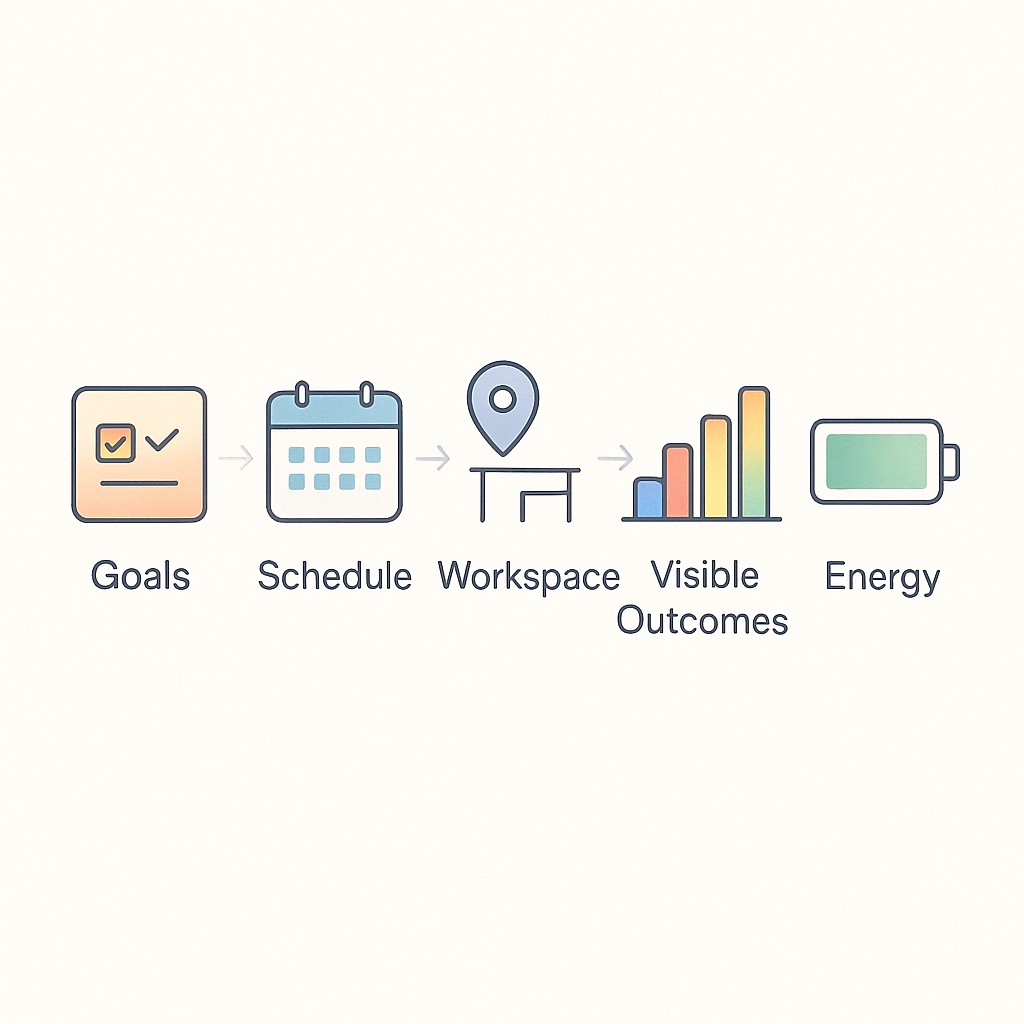Work-Life Alignment Strategies: A Practical Week for Outcomes, Energy, Boundaries, and Visibility
Work-Life Alignment Strategies: A Practical Week for Outcomes, Energy, Boundaries, and Visibility

Why Did We Ever Accept This Tradeoff?
It never made sense, but I didn’t question it for years. Forty-five minutes on the road every morning, shuffling through podcasts and traffic updates, just to reach an office where my “collaboration” consisted of one Zoom call after another. Work that could have been done from anywhere, but instead demanded my presence for no real reason. The absurdity hit hardest on those slow drives home. Zero productivity boost. Zero real collaboration. Zero energy left in the tank. How was any of this supposed to support actual life outside of work?
I kept telling myself it was normal, that things would click if I just adjusted my schedule or rearranged a few meetings. But slowly it sank in—the routine was unsustainable, and I was letting it happen. That was the moment I knew. Something had to change.
The problem was that I wasn’t using work-life alignment strategies to design my work in support of my life.
Here’s what really opened my eyes. For the first time in Workmonitor’s 22-year run, work-life balance tops pay as the leading reason people choose where to work. More than half of you said work-life balance is the most important factor in your career right now. I didn’t expect so many to pick balance over compensation, but the results were clear—this isn’t just a personal struggle. It’s the new reality for our industry.
Not salary. Even career growth finished last!
Progress Isn’t About Where You Work
The WFH vs. office argument was never really about the address in your email signature. It’s about whether you design work around life or let it constantly push against it. If you’re asking “Where should I be?” you’re already distracted from the actual question—how do I build a setup where progress and energy aren’t at odds with each other?
Here’s the real measurement problem. Most teams still track activity, hours, presence, pings—instead of building outcome-based work habits. If you’re leading engineers (or are one yourself), set this ground rule. Clarity about what matters trumps keeping busy. You don’t need to see people to know they’re producing. You need to know what progress actually looks like.
Intentional boundaries are the real antidote to both the constant blur of WFH and the slow drain of office life. Six months ago, I was chasing that green dot in Slack, thinking “online = working.” Being there isn’t being effective. Working from home, lines can melt—meetings merge into dinner, pings sneak into weekends. In the office, it’s almost the opposite: being present eats your time, whether or not there’s value. The small shift is this: set non-negotiables. Block focus hours, signal that you’re off when you’re off, close doors both digitally and physically.
In practice, people set boundaries in all kinds of ways—behavioral, temporal, communicative, and physical tactics show up strongly when working from home. There’s zero shame in making these visible to your team. That’s how you start designing days that support both deep work and actual rest.
Energy is the constraint nobody likes to admit to until they have none left. I’ve torched entire afternoons grinding through inboxes, then wondered why real work felt impossible at 3pm. It turns out nearly half of adults hit peak performance when their work matches their natural time-of-day rhythm—especially for focus and memory (see PubMed). Your battery drains faster if you work against your rhythm. Treat energy like you treat your calendar, as a hard limit.
Visibility used to mean “seen at your desk” or “active in every meeting.” What got me unstuck was flipping that: I leaned into remote visibility strategies—building visibility through what I shipped and the rituals that made progress impossible to ignore—a weekly system that compounds. It’s not about who’s loudest on Zoom. It’s about leaving artifacts—a weekly scoreboard, a quick Loom summary, a decision doc—that show what moved. Once I shifted from reactive updates to proactive scorecards, promotion conversations stopped being about where I worked and started being about outcomes.
This isn’t a call to ignore where you work; it’s a prompt to use work-life alignment strategies so location becomes just one lever. It’s about making location one lever among many, not the whole dashboard. The levers you want your hand on—clear outcomes, strong boundaries, energy-first schedules, and visible progress rituals. That’s how work finally starts supporting real life, instead of draining it.
A messy moment: I once tried working from my car during a supposed “focus morning,” thinking the novelty would trick my brain. I brought coffee, propped up my laptop on the center console, and convinced myself the hum of passing traffic would replace office noise. Fifteen minutes in, my hotspot dropped and I ended up answering a call with a sliver of bagel wedged under the space bar. I still think about that day whenever someone says “just be flexible.” Flexibility without intention is just chaos.
WFH vs. Office Success Playbook: Run a Week That Supports Your Life
Let’s break out of the WFH versus office tug-of-war. If you want work to actually support your life (not just look good on paper), run this week on repeat. Start with goals that show progress, enforce boundaries, pick where you work for a reason, use systems that follow you anywhere, and make your output visible to the people who matter. Each lever maps onto a couple days—so you’re not just changing routines, you’re practicing what works.
Day one and two are for real outcomes, not endless to-do lists. Line up what actually moves the needle: “Deliver feature X that unblocks the team,” not just “respond to Jira tickets.” Sit down with your manager—yes, even over Slack or Zoom—and clarify which outcomes matter this week and define non-negotiable outcomes. I’ll admit I used to confuse “tasks” with goals, ticking boxes but never seeing progress. The switch to concrete outcomes wasn’t automatic. It came with some awkward chats, but it kept me out of productivity limbo.
On days three and four, set work boundaries and put them front and center. Defend your calendar and attend only essential meetings—and pick your workspace on purpose. Office, home, coffee shop, park bench—it doesn’t matter, as long as you choose it to match your work or energy needs. I’ll take creative spikes at a café with uneven Wi-Fi just for the buzz, but deep work stays in a quiet corner. Give yourself permission for quirks. If it helps, write down why you’re picking that spot. The ritual does more than you think.
Day five is about operating productively anywhere. Systems make you portable—think one-tab dashboards, sync folders, and notebooks you can open from any device. I used to worry I couldn’t get deep work done unless I sat at my office desk, with my monitors perfectly arranged. Turns out, freeing myself from that was a massive relief. Now, my focus follows me.
Days six and seven? Visibility is your move. Before you log off, ship a weekly update—short Loom, scoreboard, whatever—and tie it into a monthly visibility playbook. Make your contribution obvious to anyone watching. Promotions aren’t about being present; they’re about unmistakable results. Call it #YourMove, #CareerGrowth, #Leadership if you like, but the real win is the momentum you build when your progress gets seen, not just done.
Run this week. Switch up what doesn’t work. Your outcomes, boundaries, and visibility are what drive your career now—not just the address in your email signature.
Addressing the Real Anxieties—And Making WFH Visible
I know the worry. Managers still equate commitment with butts-in-seats. I’ve played the game myself, first in, last out, hoping they’d see my “investment.” Honestly, nobody wins that contest. If you want to shift the conversation, start with outcomes, not attendance. Align with your manager on what actually matters this week and how often you’ll sync up. You don’t have to rescue their comfort with presence—give them progress and rhythm instead.
Let’s be plain. Moving remote can trigger a real fear about fading into the background, especially when recognition is tied to what people see, not what actually moves. The quick fix is to make your output legible. Visibility rituals matter—a one-minute Loom recap, a scoreboard update, even a Friday “here’s what shipped” note. That’s how projects—and promotions—get supported without being chained to the calendar.
If you’re not sure how to bring up new team norms, join the club. It’s awkward every time. The only way through is with simple, shared agreements that drive work-life alignment for engineers. I’ve seen this work. Teams who set up daily check-ins, short asynchronous threads (“What’s my blocker?”), or shared docs for weekly outcomes cut the hesitation out of remote work. Even a shared Notion with everyone’s operating hours makes a difference. Framing cuts down the back-and-forth, which stabilizes outputs. Don’t wait for someone else to formalize it; offer up one small tweak, like posting daily engineering leadership insights or ending meetings with next steps in the chat. Most of the friction is just unspoken expectation—call it out, and it gets easier.
Quick example: last fall, I rolled out a weekly outcome carousel—just a few slides or a running doc highlighting what moved, who solved what, and which experiments paid off. Nobody had to sell their work or hype achievements in DMs; the list did the work. It’s simple, but it resets recognition away from faces in the room and toward results that are easy to see. Try it. Change is contagious when it’s this visible.
The Model: Work-Life Alignment Strategies—Pick Your Week, Align Your Work
I don’t ever want to spend another forty-five minutes in traffic only to land in a day of Zoom calls and drive home exhausted. You shouldn’t have to either. Let’s not run another week that costs us both energy and purpose.

Here’s what carries forward. You build momentum by aligning work to the outcomes you care about, not the addresses you shuffle between. The actual checklist is simple and repeatable—define your goals by progress, enforce hard boundaries, pick each workspace with intention, set up systems so you’re productive anywhere, and build regular visibility in ways that support recognition and growth.
Back in those slow drives home—zero productivity, zero energy—I never imagined how much this alignment would change everything. I’ve kept my own energy and results high by mixing environments to match my focus needs, protecting time for deep work, and making outcome rituals a staple. It’s a move that adds up over time, not just for output but for my own career trajectory.
Make your outcomes and visibility unmistakable without burning energy—use AI to generate clear weekly updates, recap notes, and decision docs that travel with you, anywhere.
I’ll be honest. There are weeks I still fall back into old traps—overloaded calendars, letting lines blur, checking Slack at odd hours. I haven’t figured out how to avoid every energy dip, or every sense of “should just be busier.” Maybe I never will. But running purposefully aligned weeks is why I keep getting back on track.
So, pick a week that fits your life. Try one full run of the alignment setup, and if you learn something new about your best work or your team’s, pass it on. Running a week that actually supports your life is worth sharing.
Enjoyed this post? For more insights on engineering leadership, mindful productivity, and navigating the modern workday, follow me on LinkedIn to stay inspired and join the conversation.
You can also view and comment on the original post here .
